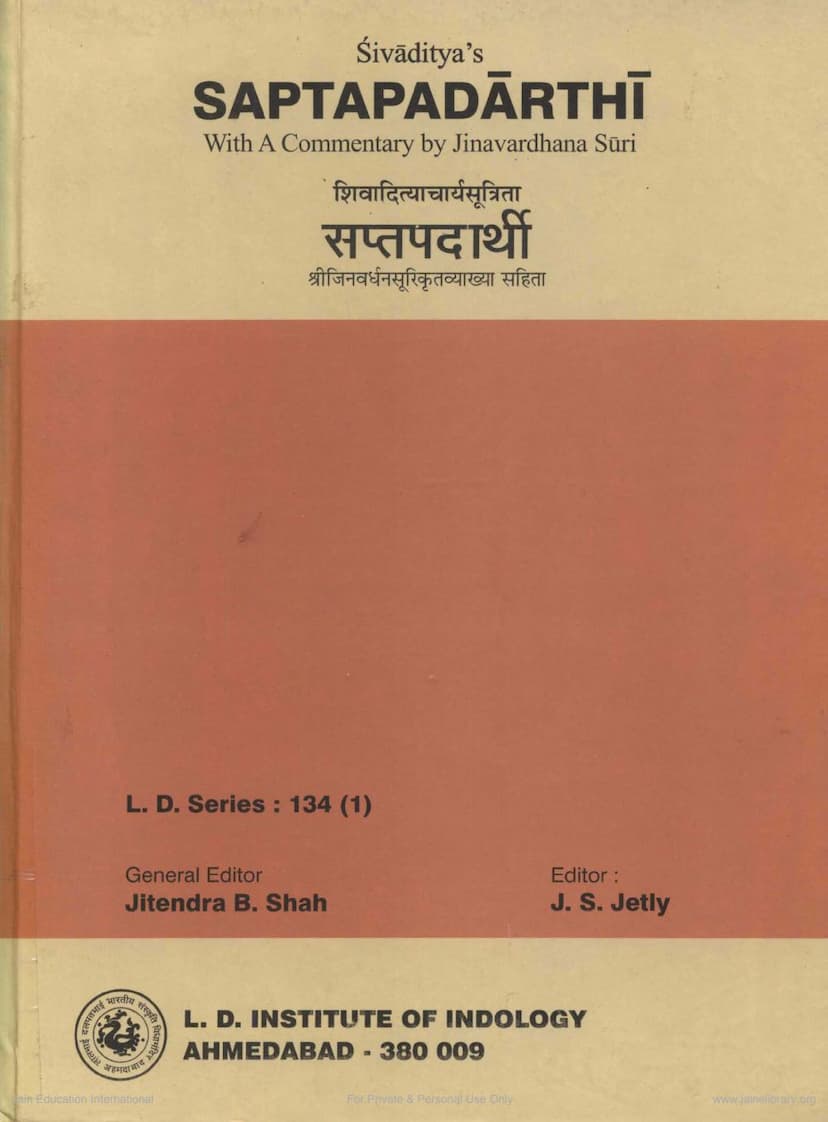Saptapadarthi
Added to library: September 2, 2025

Summary
The provided text is the Saptapadarthi by Śivaditya, a foundational text in the Vaiseṣika school of Indian philosophy, presented with a commentary by the Jainācārya Jinavardhana Sūri. The edition is published by the L. D. Institute of Indology, Ahmedabad, in their L. D. Series, Volume 134(1).
Here's a comprehensive summary of the content, drawing from the editorial notes, prefaces, introductions, and the table of contents:
Core Purpose and Significance:
- For Beginners: The Saptapadarthi is described as a "book for the beginners," particularly for students of the Vaiseṣika philosophy.
- Oldest Available Commentary: Jinavardhana Sūri's commentary is significant for being the oldest known commentary on the Saptapadarthi.
- Jaina Contribution to Non-Jaina Works: The work exemplifies the Jain tradition of engaging with and commenting on texts from other Indian philosophical schools. This practice demonstrates the Jaina scholars' broad intellectual pursuits, their commitment to knowledge, and their adherence to the principle of Anekānta (non-absolutism) by fairly representing diverse viewpoints.
- Comparative Study: Such inter-tradition commentaries facilitated a comparative study of ancient Indian philosophies.
The Vaiseṣika System and Saptapadarthi:
- The "Seven Categories" (Sapta Padārthas): The Saptapadarthi is the first work to explicitly enumerate and discuss seven categories, which are:
- Dravya (Substance)
- Guṇa (Quality)
- Karma (Action/Movement)
- Sāmānya (Generality/Universal)
- Viśeṣa (Particularity)
- Samavāya (Inherence/Conjunction)
- Abhāva (Non-existence/Absence)
- Śivaditya's Innovation: While the Vaiseṣika system is known for discussing padārthas, Śivaditya was the first to specifically list seven, notably including Abhāva (non-existence) as a distinct category, which was a significant development in the Vaiseṣika ontological framework.
Historical Context:
- Śivaditya's Dating: Based on references in other philosophical works (like those of Gangeśa and Śrīharṣa), Śivaditya is estimated to have lived around 950 CE.
- Jinavardhana Sūri's Period: Jinavardhana Sūri, the commentator, was a prominent Jain scholar and High Priest of the Kharatara Gaccha, active between 1406 CE and 1419 CE.
- Jainism's Place in Indian Thought: The introduction discusses the historical position of Jainism as a Śramana tradition, predating Buddhism, and its interactions with the Vedic and other Śramana traditions. It highlights the Jain practice of studying and commenting on non-Jaina texts as evidence of their intellectual openness and commitment to understanding various schools of thought.
Content Overview (Based on the Table of Contents):
The Saptapadarthi, with Jinavardhana Sūri's commentary, systematically explores the Vaiseṣika categories. The table of contents reveals a detailed examination of:
- Preamble: Invocation (Mangalācaraṇam), introduction to the subject matter (Padārthoddeśaḥ).
- The Seven Categories:
- Dravya (Substance): Detailed discussion of various substances, including the five Mahābhūtas (Earth, Water, Fire, Air, Ether), Time, Space, Self (Ātman), and Mind. It categorizes them into eternal (sub-atomic level) and non-eternal (effectual).
- Guṇa (Quality): Comprehensive listing and explanation of 24 qualities, including sensory qualities (form, taste, smell, touch), numerical qualities (number, magnitude), relational qualities (separateness, conjunction, disjunction, posteriority, priority), mental states (cognition, pleasure, pain, desire, aversion, effort), and physical qualities (gravity, liquidity, viscidity), as well as merit (Dharma) and demerit (Adharma), and sound. It discusses their eternal/non-eternal nature and pervasiveness.
- Karma (Action): Description of five types of actions: throwing upwards (Utkṣepaṇa), throwing downwards (Apakṣepaṇa), contraction (Ākuñcana), expansion (Prasāraṇa), and movement (Gamana). It also touches upon their classification as prescribed, prohibited, or indifferent.
- Sāmānya (Generality): Discussion of three types of universals: Supreme (Param), Inferior (Apara), and Supreme-Inferior (Parāpara). It addresses the nature of universals and their relation to particulars.
- Viśeṣa (Particularity): The concept of Viśeṣas as the differentiating principles of eternal substances, posited as infinite.
- Samavāya (Inherence): Explained as a single, eternal relationship that connects substances, qualities, and actions that are inseparable.
- Abhāva (Non-existence): Detailed analysis of four types of non-existence: prior non-existence (Prāgabhāva), subsequent non-existence (Pradhvaṁsābhāva), absolute non-existence (Atyantābhāva), and mutual non-existence (Anyonyābhāva).
- Pramāṇa (Means of Valid Cognition): A significant portion is dedicated to the epistemology, discussing:
- Pramā and Apramā: Valid cognition and invalid cognition.
- Types of Cognition: Sensory cognition (Pratyakṣa), inferential cognition (Anumāna), and the classification of their constituent elements.
- Inference: The structure of inference (Pañcāvayava) including proposition (Pratijñā), reason (Hetu), example (Udāharaṇa), application (Upanaya), and conclusion (Nigamana). It also details the types of reasons (Anvayavyatireki, Kevalānvayi, Kevalavyatireki) and logical fallacies (Hetvābhāsa).
- Other Cognitive States: Discussion of memory (Smṛti), experience (Anubhava), doubt (Saṁśaya), error (Viparyaya), contemplation (Tarka), and dream (SvApna).
- The Goal: The ultimate purpose of understanding these categories is stated to be the attainment of Niḥśreyasa (liberation or salvation) through the knowledge of reality (Tattvajñāna).
Editorial and Publication Details:
- Reprint: This edition is a reprint, addressing the high demand after the first edition went out of stock.
- Typesetting: The reprint features fresh computer typesetting.
- Acknowledgements: Thanks are extended to the Sharadaben Chimanbhai Education Research Centre and Shri Naranbhai Patel for their assistance.
- Legacy: The editorial and preface sections acknowledge the contributions of Dr. J.S. Jetly (editor of the first edition) and Pt. Dalsukhbhai Malvania (Director of the Institute and General Editor of the L.D. Series), both of whom are deceased.
In essence, the Saptapadarthi, as presented in this edition with Jinavardhana Sūri's commentary, serves as a vital resource for understanding the fundamental principles of Vaiseṣika philosophy from a Jaina perspective, highlighting its detailed ontological and epistemological framework and the intellectual engagement of Jain scholars with the broader Indian philosophical landscape.